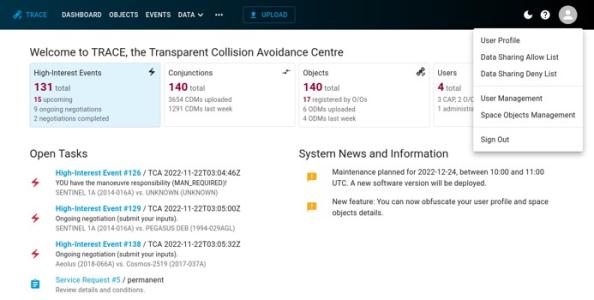Software technologies supporting CREAM
Programme
GSTP
Programme Reference
GT17-413SD
Prime Contractor
Airbus Defence and Space GmbH
Start Date
End Date
Status
Closed
Country
Germany

Objectives
The objective of the activity is to develop key software components prototype and tests of future CREAM systems supporting automated coordination and communication of operators and spacecraft as well as catalogue data providers.
Description
;;
ESA's Space Safety Programme contains a cornerstone quot;Collision Risk Estimation and Automated Mitigation (CREAM)quot;. CREAM addresses the development of technologies for automating collision avoidance.
;
Today, active collision avoidance has become a routine task in space operations, relying on validated, accurate and timely space surveillance data. For a typical satellite in LEO, hundreds of conjunction alerts can be expected every week. Processing and filtering these still leaves about two actionable alerts per spacecraft and week requiring detailed follow-up by an analyst. At ESA, more than one collision avoidance manoeuvre can be expected per satellite and year. It is clear that such an approach requiring 24/7 expert availability to analyse more than 20 parameters and constraints generates high operational costs. The future with an accelerating launch rate and deployments of smaller satellites and constellations, as well as improved space surveillance networks delivering catalogues of up to 200k objects will render efforts by any operator following this approach an unmanageable task.
;
Activities under the Space Safety Programme address automating decision processes for collision avoidance manoeuvres, and the development and testing of late commanding paths and related operations concepts.
;
This complementary and coordinated activity shall support these programme activities. The activity shall focus on ensuring data integrity via secure communication and ensuring proper role-based access control. Approaches applied in other industries (such as automotive or railway) may be taken into account and possibly reused with some modification.
;
The main tasks of the activity are:
-
- Establish user and system requirements for an infrastructure supporting automatic communication and coordination. It is envisaged that this covers at least access control, data integrity and encryption.
- Review existing mechanisms and formats for inter-operator data exchanges (also covering non-space industries) assessing their suitability for CREAM.
- Define an architecture for the CREAM data exchange mechanism including new or derived protocols if needed.
- Develop key SW components of this architecture and validate them against the requirements. Ideally these SW components are integrated into a complete chain.
;
;
Application Domain
Generic Technologies
Technology Domain
10 - Flight Dynamics and GNSS
11 - Space Debris
Competence Domain
10-Astrodynamics, Space Debris and Space Environment
Initial TRL
TRL 3
Target TRL
TRL 5
Achieved TRL
TRL 5
Public Document
Executive Summary
Final Presentation
